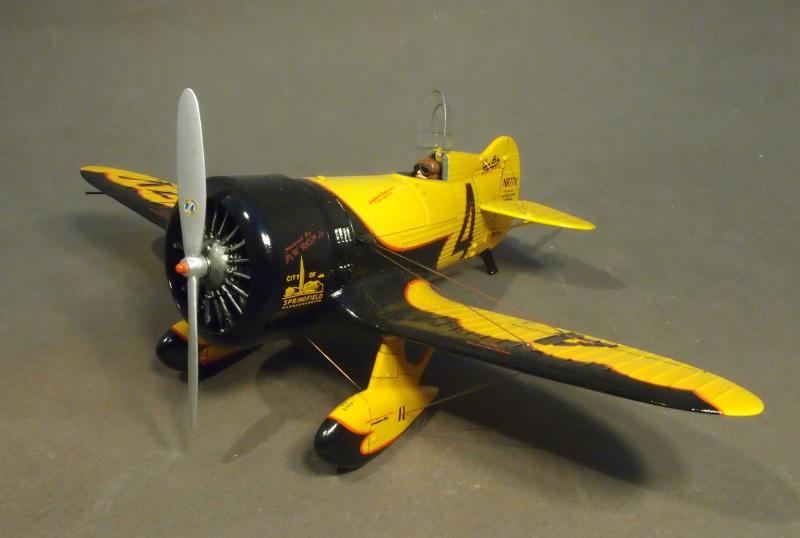Geebee Racer Z40, “City of Springfield”, Pilot, Lowell Bayles, Thompson Trophy Winner, 1931—The Speedbirds Collection
$198.00
Item Number: SB-03
The Thompson Trophy race was one of the National Air Races of the heyday of early airplane racing in the 1930’s. Established in 1929, the last race was held in 1961. The race was 10 miles (16 km) long with 50-foot-high (15 m) pylons marking the turns, and emphasized low altitude flying and maneuverability at high speeds. As the race was flown around a closed course, crowds in the grandstands could easily see much of the spectacle.
There were two series of Thompson races. The first series followed the award of a "Thompson Cup" in the 1929 National Air Races to the winner of the "International Land Plane Free-For-All" (that is, the unlimited class race). Thompson Products (a predecessor to TRW) decided to sponsor a trophy to be awarded for the next ten years for unlimited class racing (though a stipulation was eventually added excluding women pilots). The trophy was designed by Walter Sinz and is now at Air and Space Museum. Sinz also made a pair of 10-foot-tall (3.0 m) models of the trophy for promotional purposes. Races were held for the next ten years, ending in 1939. Further races in this series were precluded by the onset of war.
After World War II, the original trophy was (according to stipulation) retired. Also, advances in airplane technology, especially the advent of the turbojet, complicated matters. It was decided to establish a new series, with "R" (piston engine) and "J" (jet-powered) divisions. The "R" class was for civilian competition; the "J" division was for military pilots and was administered by the United States Air Force. Roscoe Turner, the last winner of the pre-war trophy, refused to relinquish it, but the original molds were located, and two additional casts were made, differing only in the legend engraved at the base and by placards identifying the division. Division "R" races were held from 1946 to 1949; Division "J" races (also known as "Military Speed Dashes") were held from 1951 to 1961, excepting 1952 and 1960.
The Granville Gee Bee Model Z was an American racing aircraft of the 1930’s, the first of the Super Sportster aircraft built by Granville Brothers Aircraft of Springfield, Massachusetts, with the sole intent of winning the Thompson Trophy, which it did in 1931. However, it soon suffered a fatal crash during a world speed record attempt, starting the reputation of the Gee Bee aircraft as killers.
Suffering from the effects of the Great Depression, the Granville Brothers decided in July 1931 to build an aircraft to compete in that fall's Thompson Trophy competition at the National Air Races in Cleveland, Ohio. They hoped that a victory in the prestigious race would lead to additional orders for their line of sporting aircraft.
Constructed in less than five weeks at a cost of under $5,000 USD, the Gee Bee (for "Granville Brothers") Model Z, named City of Springfield, was a small, tubby airplane. It was essentially the smallest possible airframe constructed around the largest possible engine, a supercharged Pratt & Whitney R-985 "Wasp Junior" radial engine, producing 535 horsepower (399 kW).
First flying on August 22, 1931, the Gee Bee Z quickly proved to be tricky to fly, but fulfilled every expectation with regards to its speed. Flown by pilot Lowell Bayles, the Gee Bee Z attained the speed of 267.342 miles per hour (430.245 km/h) at the National Air Races during the Shell Speed Dash qualifying on September 1 then went on to win the Goodyear Trophy race, run over a course of 50 miles (80 km), the next day at an average speed of 205 miles per hour (330 km/h). On the September 5, the aircraft's engineer, Bob Hall, flew the Gee Bee Z to victory in the General Tire and Rubber Trophy race, then won again the next day in a free-for-all event.
In the Thompson Trophy Race on September 7, Bayles was triumphant, winning with an average speed of 236.24 miles per hour (380.19 km/h), winning over competitors including Jimmy Doolittle, James "Jimmy" Wedell, Ben Howard, Dale Jackson, Bill Ong, Ira Eaker, and Hall, who finished fourth in a Gee Bee Model Y.
Following the Thompson Trophy race, the Gee Bee Z was re-engined with a larger, 750-horsepower (560 kW) Wasp Senior radial, in preparation for an attempt at establishing a world speed record for landplanes at Wayne County Airport in Detroit, Michigan. Unofficially clocked at 314 miles per hour (505 km/h) on a trial run, it surpassed the previous record of 278 miles per hour (447 km/h) by attaining 281.75 miles per hour (453.43 km/h) on December 1, 1931, but the margin was too small for the record to be officially registered. A further record attempt on December 5, 1931, would end in tragedy, the aircraft suffering a wing failure and rolling into the ground, killing Bayles
It was suspected that the Model Z's crash during a speed run in December 1931 was due to an unexpected failure of the gasoline tank cap, which may have come loose and passed through the windshield. A bullet-proof windscreen and internal fuel caps were part of the new design. Analysis of motion picture film of the event examined frame-by-frame is inconclusive. Control surface flutter is a more likely cause. It is theorized that the gas cap struck the pilot and incapacitated him, causing a sudden upset in pitch that led to uncontrolled flutter in the right aileron which imparted undue stress on that wing, causing it to pitch up sharply and fail. In addition, tests of a reproduction aircraft have shown that the Gee Bee Z was susceptible to aerodynamic flutter at high speed. The 1932 R-1 and its sister ship, the R-2, were the successors of the previous year's Thompson Trophy-winning Model Z.
Box Size: 11”x 10 ½” x 5”


